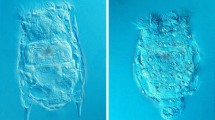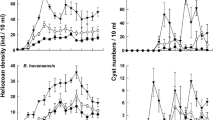Abstract
A new culture method for K. cochlearis has made it possible to study isolated animals and to investigate the population dynamics of this pelagic rotifer species. The duration of principal developmental stages diminishes continuously with temperature. Decreased survival was associated with a reduced duration of individual fecundity. The age distribution of the population shifted toward younger age intervals with higher temperatures. Growth rates had an optimum at 15°C; the population dynamics, while lower for K. cochlearis than for some other rotifers, were in good agreement with field data.
Similar content being viewed by others
References
Allan, J. D., 1976. Life history patterns in zooplankton. Am. Nat. 110: 165–180.
Andrewartha, H. G. & Birch, L. C., 1954. The distribution of animals. Publ., Lond.
Baker, R. L., 1979. Birth rates of planktonic rotifers in relation to food concentration in a shallow, eutrophic lake in western Canada. Can. J. Zool. 57: 1206–1214.
Birch, L. C., 1948. The intrinsic rate of natural increase of an insect population. J. anim. Ecol. 17: 15–26.
Bosselmann, S., 1979. Population dynamics of Keratella cochlearis in Lake Esrom. Arch. Hydrobiol. 87: 152–165.
Chu, S. P., 1942. The influence of mineral composition of the medium on the growth of planktonic algae. 1. Methods and culture media. J. Ecol. 30: 284–325.
Edmondson, W. T., 1960. Reproductive rates of rotifers in natural populations. Mem. Ist. ital. Idrobiol. 12: 21–77.
Edmondson, W. T., 1965. Reproductive rates of planktonic rotifers as related to food and temperature in nature. Ecol. Monogr. 35: 61–112.
Gilbert, J. J., 1970. Monoxenic cultivation of the rotifer Brachionus calyciflorus in a defined medium. Oecologia 4: 89–101.
Gilbert, J. J., 1980: Further observations on developmental polymorphism and its evolution in the rotifer Brachionus calyciflorus. Freshwat. Biol. 10: 281–294.
Halbach, U., 1970. Einfluβ der Temperatur auf die Populationsdynamik des planktischen Rädertieres Brachionus calyciflorus Pallas. Oecologia 4: 176–207.
Hofmann, W., 1972. Zur Populationsökologie des Zooplanktons im Pluβsee. Verb. int. Ver. Limnol. 18: 410–418.
Hummon, W. D. & Bevelhymer, D. P., 1980. Life table demography of the rotifer Lecane tenuiseta under culture conditions and various age distributions. Hydrobiologia 70: 25–28.
Krebs, C. J., 1972. Ecology: The Experimental Analysis of Distribution and Abundance. N.Y.
Lindström, K. & Pejler, B., 1975. Experimental studies on the seasonal variation of the rotifer Keratella cochlearis (Gosse). Hydrobiologia 46: 191–197.
Mertz, D. B., 1970. Notes on methods used in life — history studies. In Connel, J. H., Mertz, D. B. & Murdoch, W. D. (eds), Readings in Ecology and Ecological Genetics. Publ., N.Y.: 4–17.
Müller, H., 1972. Wachstum and Phosphatbedarf von Nitzschia actinastroides (Lemm) v. Goor in statischer and homokontinuierlicher Kultur unter Phosphatlimitierung. Arch. Hydrobiol. Suppl. 38: 399–484.
O'Flaherty, L. M. & Phinney, H. K., 1970. Requirement for the maintenance and growth of Aphanizomenon flos-aquae in culture. J. Phycol. 6: 95–97.
Paloheimo, J. E., 1974. Calculation of instantaneous birthrates. Limnol. Oceanogr. 19: 692–694.
Pejler, B., 1977. Experience with rotifer cultures based on Rhodomonas. Arch. Hydrobiol. Beih. 8: 264–266.
Piavaux, A., 1970. Sur la durée de développement des oeufs immédiates de quelques rotifères. Ann. Soc. r. zool. Belg. 99: 237–248.
Pourriot, R., 1965. Recherches sur l'ecology des Rotifères. Vie Milieu, Suppl. 21: 1–224.
Pourriot, R., 1972. Influence de la teneur en protéins, de la température et du jeûne sur la respiration de Rotifères héléo-planctoniques. Verh. int. Ver. Limnol. 18: 1429–1433.
Pourriot, R., 1973. Rapports entre température, tailles des adultes, longuer des oeufs et taux de développement embryonaire Brachionus calyciflorus P. (Rotifère). Ann. Hydrobiol. 4: 103–115.
Pourriot, R., 1980. Workshop on culture techniques of rotifers. Hydrobiologia 73: 33–35.
Pourriot, R. & Deluzarches, M., 1971. Recherches sur la biologic des Rotifères. 2. Influence de la température sur la durée du développement embryonnaire et post-embryonnaire. Ann. Limnol. 7: 25–52.
Pourriot, R. & Rieunnier, M., 1973. Recherches sur la biologic des Rotifères. 3. Fécondité et durée de vie comparées chez les femelles amictiques et mictiques de quelques espèces. Ann. Limnol. 9: 241–258.
Pourriot, R. & Rougier, C., 1975. Dynamique d'une population expérimentale de Brachionus dimitatus (Bryce) (Rotifère) en fonction de la nourriture et de la témperature. Ann. Limnol. 11: 125–143.
Provasoli, L., J. A. McLaughlin & M. R. Droop, 1975. The development of artificial media for marine algae. Arch. Mikrobiol. 25: 392–428.
Provasoli, L. & Pintner, 1. J., 1960. Artificial media for freshwater algae: Problems and suggestions. Pymatuning Symposia in Ecology, Spec. Publ. 2, University Pittsburgh Press.
Rigler, F. H., MacCallum, M. E. & Roff, J. C., 1974. Production of zooplankton in Char Lake. J. Fish. Res. Bd Can. 31: 637–646.
Seitz, A., 1979. On the calculation of birth rates and death rates in fluctuating populations with continous recruitment. Oecologia 41: 343–360.
Siebeck, O. & Lutz, A., 1980. Baggerseen im stadtnahen Bereich — eine limnologische Betrachtung zur Nutzung and Erhaltung als Badegewässer. Verh. Gesellsch. Ökol. 8: 327–334.
Sperling, A., 1981. Das Rotatorienplankton des Fasaneriesees im Sommer 1979. Staatsexamensarbeit Univ. Munchen.
Steiff, B., 1981. Das Zooplankton des Fasaneriesees im Winterhalbjahr 1979/1980. Staatsexamensarbeit Univ. Munchen.
Stemberger, R. S., 1981. A general approach to the culture of planktonic rotifers. Can. J. Fish. aquat. Sci. 38: 721–724.
Walz, N., 1983. Continuous culture of rotifers Keratella cochlearis and Brachionus angularis. Arch. Hydrobiol., in press.
Winberg, G. G., 1971. Methods for the Estimation of Production of Aquatic Animals. Publ. Lond.
Zimmermann, C., 1974. Die pelagischen Rotatorien des Sempachersees, mit spezieller Berücksichtigung der Brachioniden and der Ernährungsfragen. Schweiz. Z. Hydrobiol. 36: 205–300.
Author information
Authors and Affiliations
Rights and permissions
About this article
Cite this article
Walz, N. Individual culture and experimental population dynamics of Keratella cochlearis (Rotatoria). Hydrobiologia 107, 35–45 (1983). https://doi.org/10.1007/BF00126701
Received:
Revised:
Accepted:
Issue Date:
DOI: https://doi.org/10.1007/BF00126701




